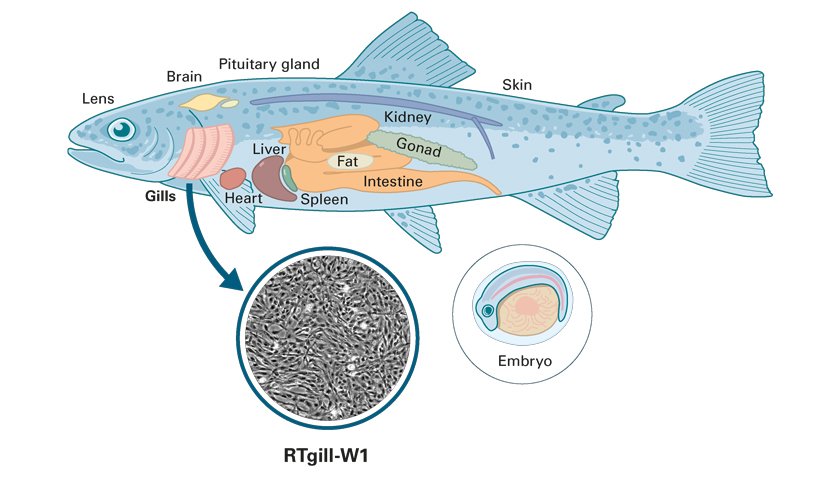‘Virtual Fish’ Could Save Animals from Chemical Toxicity Tests
Scientists in Switzerland are developing a groundbreaking biomedical research method that doesn’t expose live fish to cruel laboratory experiments.
This story is supported by
For decades, fish have been used in biomedical research, as test subjects for chemicals' toxicity; as models for human growth and disease; and in aquaculture research to increase the farming of fish for human consumption. Due to their small size and low cost, these animals have become a ‘convenient’ test subject for many scientists. But as ethical concerns surrounding animal experimentation continue to grow, researchers are searching for solutions to remove live animals from the process.
Now, scientists in Switzerland are working to create ‘virtual fish’ that can be used instead of their animal counterparts to test the toxicity of chemical substances. To do this, a combination of cultured fish cells (also known as in vitro) and advanced computer-modeling (often called silico models) are used. To obtain the cultured fish cells, scientists started by isolating the cells through a one-time biopsy. The cells can be multiplied as often as desired, and so removing the need for any animals in future processes.
The joint research project between Eawag, the aquatic research institute, and the University of Utrecht, was overseen by the German cell biologist and toxicologist Kristin Schirmer, and recently secured nearly $1million in funding to bring this fish-free biomedical research one step closer. The project is supported by the Swiss National Science Foundation as part of their new research program, "Advancing 3Rs - Animals, Research and Society", that aims to reduce and replace animal experiments in scientific research over the course of five years.
Every year, between 3.5 -7 million fish are used in the U.S. alone. Meanwhile, in the EU, more than one million fish are used for toxicity testing and scientific research, with around 400 fish required for a single fish early-life stage test (to establish the lethal and sub-lethal effects of chemicals on the early life stages of the species). In addition to causing intense animal suffering, these traditional tests are complex, expensive and take weeks or months to complete.
The results of a test by Schirmer’s team based on rainbow trout gill cells was released last year by the Organisation for Economic Cooperation and Development (OECD) as the latest guideline in the field of environmental toxicology. “We chose gill cells because it is the gills that first come into contact with chemicals in water due to their large surface area in the fish,” explained Schirmer. “So by observing how the gill cells are damaged by a chemical, we can predict how that chemical would affect a living fish.”
Results were available after just five days, and were in accordance with data from independently conducted in vivo (live animal) investigations. “This is a major step towards simpler, less expensive and more rapid toxicity testing for the authorisation and use of new chemicals. It's the first time we've been able to use cell cultures to accurately predict chemical effects on growth which would only emerge after weeks or even months in live fish."
Credit: zeichenfabrik
Now, tests on other significant organs, including the gut or nerve cells of rainbow trout, are being developed to gain a more complete understanding of how chemicals can affect fish.
“Our vision is that the data from the in-vitro tests on cells of all major organs will flow into a single computer model, the virtual fish,” said the project research group leader, Ksenia Groh. This should enable detailed and reliable results on how chemicals impact fish – without having to expose living animals to experimentation.
In addition, the project strives to work closely with the chemical industry as well as the authorities in charge of approving new chemicals.
“We want to develop the virtual fish together with them in order to align the process from development to application at the regulatory level to the effective needs – which in the case of the gill test took twelve years - and thus speed it up,” said Groh. “Early involvement of the players is important so that the requirements posed by later implementation can already be taken into account during development of the methods. In this way, animal testing can be replaced more quickly in practice.”
We Have A Favor To Ask…
Species Unite amplifies well-researched solutions to some of the most abusive animal industries operating today.
At this crucial moment, with worldwide momentum for change building, it’s vital we share these animal-free solutions with the world - and we need your help.
We’re a nonprofit, and so to keep sharing these solutions, we’re relying on you - with your support, we can continue our essential work in growing a powerful community of animal advocates this year.
More stories:
Species Unite
A collection of stories of those who fight the good fight on behalf of animals.






The whereabouts of two baby giraffes remain unknown after a zoo owner withheld their location and was jailed for contempt.